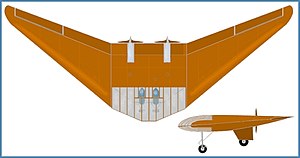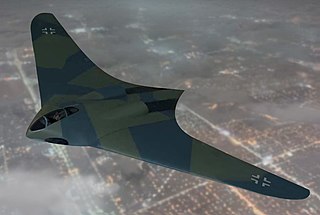
The Horten H.IX, RLM designation Ho 229 was a German prototype fighter/bomber designed by Reimar and Walter Horten to be built by Gothaer Waggonfabrik. Developed at a late stage of the Second World War, it was one the first flying wing to be powered by jet engines.
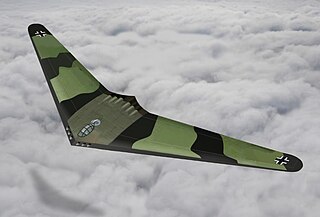
The Horten H.XVIII was a proposed German World War II intercontinental bomber, designed by the Horten brothers. The unbuilt H.XVIII represented, in many respects, a scaled-up version of the Horten Ho 229, a prototype jet fighter. The H.XVIII was one of many proposed designs for the Langstreckenbomber, and would have carried sufficient fuel for transatlantic flights.

The Horten H.IV was a German tailless flying wing glider in which the pilot was to lie in a prone position to reduce the frontal area, and hence drag. It was designed by Reimar and Walter Horten in Göttingen. Four were built between 1941 and 1943. They were flown in a number of unofficial competitions in Germany during World War II. After the war the flying examples were transported to the United Kingdom and the United States where several contest successes were achieved.
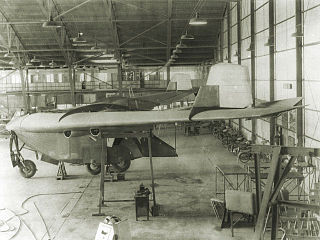
The DINFIA IA 38 was a 1960s Argentine four-engine experimental tailless transport aircraft, designed under the direction of Reimar Horten and based on the German Horten Ho VIII project and built by the DINFIA.

The Fauvel AV.22 was an unorthodox glider produced in France in the 1950s, 60s, and 70s. Originally intended to be produced in series, it was later marketed to homebuilders. Like other Charles Fauvel designs, it was a tailless aircraft, and this particular design featured wings with a slight forward sweep.

The SZD-48 Jantar Standard 2 is a Standard Class glider that was designed and produced in Poland starting in 1977.

The I.Ae. 34 Clen Antú, sometimes known as the Horten XVa after its designer Reimar Horten, was a two-seat tailless glider built in Argentina. Two single-seat variants competed unsuccessfully in the 1952 World Gliding Championships.
The TeST TST-13 Junior is a single-seat touring motor glider with a nose-mounted engine, built by TeST in Czech Republic. It is an all composite design which succeeded the TeST TST-9 Junior motor glider in production, incorporating some features of the TeST TST-10 Atlas sailplane, including its wing.

The I.Ae.41 Urubú was a two-seat flying wing tailless glider, built in Argentina by the Fábrica Militar de Aviones (FMA) in the 1950s.

The Horten H.III was a flying wing sailplane built by Walter and Reimar Horten in Germany from 1937 to 1944.
The Nike PUL 9 is an Argentine experimental tailless aircraft powered by a Rotax 447 engine.

The Ameur Altania was a single-engine light aircraft of pusher configuration with side-by-side seats for two and a V-tail, designed in France in the 1990s. Several prototypes were built and flown, including a 15 m span motorglider version; the final prototype was constructed from carbon composites rather than glass fibre. Another version, the UCA Carbon Bird has been built by Universal Composite Aviation after the bankruptcy of Ameur Aviation.
The IAE VUT Marabou was built as a piloted test vehicle to develop autonomous control of unmanned aerial vehicles (UAVs) flying in civil airspace. Czech-designed and constructed, it first flew in April 2010.
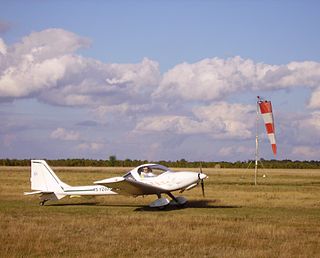
The Aviakit Véga is an ultralight aircraft seating two in side-by-side configuration. It was designed in France in the late 1990s to be easily constructed by amateurs from kits and was offered with a choice of three engines and of tricycle or conventional undercarriages.

The TechProAviation Merlin HV 100 is a Czech amateur-built aircraft, designed and produced by TechProAviation of Olomouc. The aircraft is supplied as a kit for amateur construction.

The Horten H.II Habicht (Hawk) was a German flying wing glider built in Germany in 1935. Four, including one flown mostly as a motorglider, were built. One of the gliders was used to test the aerodynamics of a prototype World War II Horten jet fighter-bomber.

The Horten H.I was a German flying wing research glider built by Walter and Reimar Horten in 1933.

The Horten H.VII was a flying wing fighter-trainer aircraft designed by the Horten brothers in Nazi Germany during World War II.
The Horten H.VIII was a flying wing research aircraft designed by Reimar Horten during World War II and only partly built by the end of the war.

The Horten H.XIII was an experimental flying wing aircraft designed by the Horten brothers during World War II.
